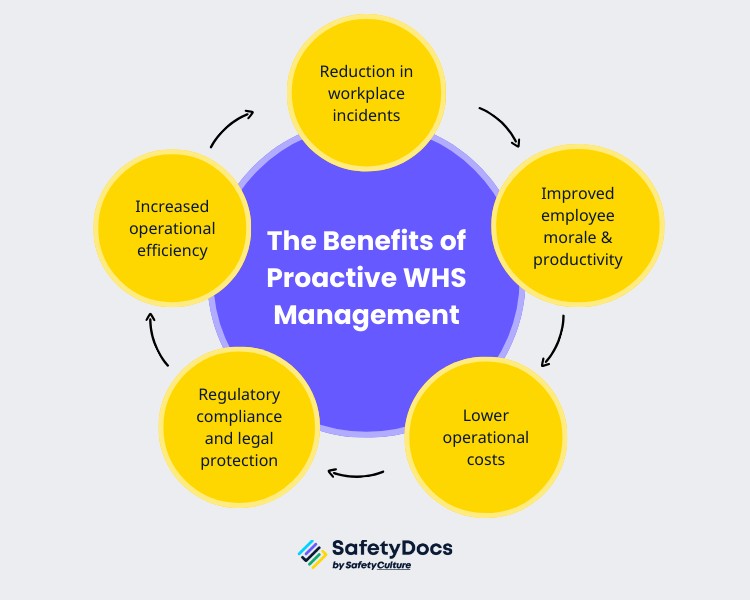While Workplace Health and Safety (WHS) management is essential for protecting employees and ensuring operational efficiency, many organisations still operate with a reactive approach, responding to incidents after they occur. With a 5% increase in fatalities resulting from work-related injuries according to recent reports, transitioning to proactive WHS management can help businesses prevent workplace incidents from happening in the first place, reducing risks and fostering a culture of safety.
This guide explores the steps that you can take to shift from reactive to proactive WHS management, leveraging technology, continuous improvement practices, and a strong safety culture.
What is Proactive WHS Management?
Proactive WHS management focuses on identifying and mitigating risks before incidents occur. Unlike reactive WHS, which addresses safety issues after they happen, proactive WHS involves continuous monitoring, predictive analytics, and employee engagement. The benefits of proactive WHS management include:
Reduction in Workplace Incidents
Proactive WHS management involves early risk detection and mitigation, which significantly reduces the likelihood of workplace incidents. This approach uses predictive analytics and continuous monitoring to identify potential hazards before they become incidents. By addressing these risks proactively, organisations can prevent accidents, injuries, and fatalities, thereby creating a safer work environment for all employees.
Improved Employee Morale and Productivity
A stronger safety culture fosters an environment where employees feel valued and supported. When employees perceive that their safety is a priority, it boosts their morale and motivation. This, in turn, leads to increased productivity as employees are more engaged and focused on their work. A proactive safety approach also promotes a more robust line of communication between leadership and employees, encouraging participation in safety initiatives, further enhancing this positive impact.
Lower Operational Costs
Workplace injuries, absenteeism, and downtime can significantly increase operational costs. Proactive WHS management helps reduce these costs by minimising the occurrence of incidents. This results in less time spent on incident investigations, fewer medical expenses, and reduced absenteeism due to injuries. Additionally, proactive safety measures can prevent costly legal and regulatory penalties associated with non-compliance.
Regulatory Compliance and Legal Protection
Maintaining thorough safety documentation and procedures is crucial for regulatory compliance. Proactive WHS management ensures that all necessary safety protocols are in place and documented, providing legal protection in case of audits or investigations. This proactive approach demonstrates a commitment to safety, which can mitigate legal liabilities and protect the organisation's reputation.
Increased Operational Efficiency
Proactive WHS management reduces workplace incidents, leading to fewer disruptions in operations. This means smoother workflows, as there are fewer interruptions due to accidents or injuries. With a safer and more efficient work environment, organisations can achieve higher productivity levels. Additionally, proactive safety measures can help streamline processes and improve overall operational performance.
By integrating proactive WHS management into daily operations, businesses can create safer workplace environments and improve long-term financial and reputational outcomes.

Key Differences Between Reactive and Proactive WHS
Understanding the clear distinction between reactive and proactive WHS approaches is important for those who aim to improve the safety performance of their organisation. Here is a comparison between the two WHS approaches:

Shifting to a proactive WHS model helps organisations stay ahead of risks, protecting both employees and business operations from preventable harm.
Steps to Transition to Proactive WHS
To successfully transition from reactive to proactive WHS management, businesses can follow these actionable steps:
1. Conduct Regular Risk Assessments
- Identify Potential Hazards: The steps to proactive WHS management starts with identifying hazards. Conduct frequent workplace inspections, safety audits, and hazard assessments to pinpoint risks. Engage employees throughout this process to ensure a comprehensive understanding of workplace risks.
- Consult with Workers: Involve workers not only in identifying hazards and but also in suggesting practical control measures, as they often have unique insights into workplace conditions.
2. Implement Predictive Safety Tools
- Wearable Safety Devices: Along with the standard Personal Protective Equipment (PPE), implement wearable devices that can detect and alert workers to potential hazards in real-time.
- Digital Reporting Systems: Use digital tools to streamline incident reporting and facilitate quick action on safety concerns.
3. Engage Workers in Safety Planning
- Open Communication Channels: Establish open communication to encourage collaboration in safety programs. This fosters employee buy-in and provides workers with a platform to identify risks and propose improvements.
- Regular Safety Meetings: Hold regular meetings to discuss safety issues and involve workers in decision-making processes related to WHS.
4. Adopt WHS Management Templates
- Standardised Procedures: Implement standardised safety procedures and templates to ensure compliance, consistency, and efficiency in WHS documentation and reporting.
- Compliance with Regulations: Ensure that all templates and procedures comply with Australian WHS laws and regulations.
5. Enhance Safety Training Programs
- Comprehensive Training: Provide ongoing education on hazard recognition, emergency response, WHS regulations, and best practices to empower employees with the knowledge needed to stay safe.
- Industry-Specific Training: Customise training programs to address specific hazards relevant to the industry or workplace.
6. Monitor and Review Safety Data
- Regular Audits and Assessments: Regularly assess incident reports, workplace safety metrics, and audit results to identify areas for improvement.
- Optimise Workflows: Use data insights to optimise workflows and enhance safety procedures.
7. Encourage a Reporting Culture
- Safe Reporting Environment: Foster a workplace culture where employees feel comfortable reporting near misses, unsafe conditions, and safety concerns without fear of retaliation.
- Recognition and Feedback: Recognise and provide feedback on safety reports to encourage ongoing participation.
Building a Safety Culture
A proactive safety culture is driven by leadership commitment, employee involvement, and ongoing training. Key to building a safety culture involves the following:
- Leadership Support: Management must lead by example, prioritising WHS in daily operations and encouraging employees to actively participate in safety initiatives.
- Employee Training & Engagement: Continuous safety education, interactive training programs, and real-life scenario-based learning help reinforce best practices and ensure all workers remain vigilant.
- Transparent Communication: Open discussions about hazards, safety improvements, and performance reviews foster trust, accountability, and collaboration between management and employees.
- Recognition and Incentives: Rewarding proactive safety behaviours, such as hazard reporting and adherence to WHS protocols, helps reinforce a culture of continuous improvement and vigilance.
Having a line of communication across the board fosters employee buy-in, leading to well-established proactive participation to keep the workplace safe and build a safety culture.

Leveraging SafetyDocs for Proactive WHS Management
Transitioning to proactive WHS management requires robust documentation, streamlined processes, and reliable tools for safety. SafetyDocs offers a comprehensive suite of WHS Management System Templates, Risk Management Plans, and Incident Management Plans designed to standardise and enhance safety strategies across organisations.
Streamlining Incident Reporting
SafetyDocs templates enable businesses to efficiently document and manage incident reports, ensuring timely responses and minimising workplace disruptions. By standardising incident reporting processes, organisations can quickly identify patterns and take proactive measures to prevent future incidents.
Simplified Risk Assessments
The structured templates provided by SafetyDocs support thorough hazard identification, implementation of control measures, and prioritisation of risks. This structured approach allows businesses to proactively address potential threats, ensuring a safer work environment.
Enhanced Safety Planning
A well-defined safety management system, supported by SafetyDocs templates, provides a structured framework for maintaining proactive WHS practices and ensuring regulatory compliance. By utilising these templates, businesses can efficiently document, implement, and enhance their WHS procedures, enabling them to predict and prevent risks effectively.
Overall, SafetyDocs templates play a crucial role in streamlining processes such as incident reporting, risk assessments, and safety planning, thus empowering organisations to predict and prevent risks effectively, ensuring a safer and more compliant workplace.

Continual Improvement and Monitoring
Sustaining proactive WHS management requires ongoing monitoring, evaluation, and refinement of safety processes. Businesses should:
- Perform Regular Audits: Scheduled safety audits and workplace inspections help identify gaps in current WHS procedures and ensure compliance with industry regulations.
- Analyse Safety Data: Collect and evaluate safety performance metrics, incident reports, and near-miss records to identify trends, root causes, and areas for improvement.
- Establish Feedback Loops: Encourage employees to provide feedback on safety policies, report safety concerns, and contribute to the refinement of WHS programs.
Real-world Examples
City of Ryde’s PErforM Program: The City of Ryde implemented the program to address manual handling risks. They implemented changes such as using hoists for lifting machinery and redesigning work areas to reduce hazards. These changes significantly improved workplace safety and reduced injuries related to manual handling.
A mining company implemented a real-time monitoring system that used sensors to track the location and condition of workers in underground mines in real-time. This proactive system allowed the company to quickly respond to emergencies and improve worker safety in one of the most dangerous industries in the world.
These case studies show that organisations prioritising continuous improvement in safety experience fewer incidents, higher compliance rates, and stronger overall safety cultures.
Proactive WHS Management
Transitioning to proactive WHS management is essential for workplace incident prevention, improving compliance, and fostering a culture of safety. By implementing regular risk assessments, engaging workers, leveraging WHS technology for monitoring, and making use of SafetyDocs management templates to predict and prevent risks, businesses can take a strategic proactive approach to workplace safety.
A well-executed proactive WHS management system protects employees and strengthens business resilience, operational efficiency, and overall sustainability. Organisations that commit to proactive safety strategies experience lower incident rates, reduced costs, and enhanced reputations as leaders in workplace safety.
Implement Proactive WHS Management with SafetyDocs Today
Are your WHS practices proactive enough to prevent incidents before they occur? Explore SafetyDocs solutions to enhance your organisation’s safety strategies:
Contact us today for personalised advice on building a proactive WHS management framework tailored to your business.
Our team of experts is dedicated to providing accurate and informative content. Craig Cruickshank, our senior HSEQ advisor at SafetyDocs by SafetyCulture has reviewed this blog post to ensure the highest level of quality.
Learn more about Craig's work on LinkedIn for more industry insights.
Available for instant download and supplied in fully editable MS Word format for use in your business.
Please note that the above information is provided as a comment only and should not be relied on as professional, legal or financial advice.
Share This Article
